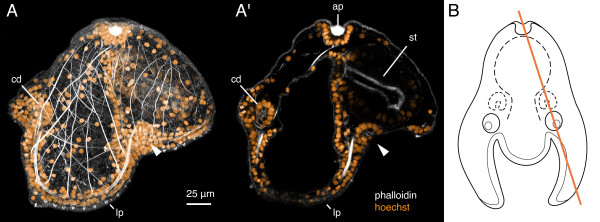Figure 7.
Trunk disc invaginations in a 10-day-old pilidium of Micrura alaskensis. A, A' Confocal images of the pilidium larva stained with phalloidin (white) and hoechst (orange). Apical organ is up, anterior lobe to the left. A. A z-projection of the entire larva, viewed from the left side. The left cephalic disc (cd) and the left trunk disc (arrowhead) are discernible as two dense clusters of nuclei in vicinity of the ciliated band at the anterior and posterior margin of the left lateral lappet (lp). A'. A sub-stack (3.3 μm thick) of the same larva, which highlights the left trunk disc invagination (arrowhead), which originates from subumbrellar pilidial epidermis, i.e. below the ciliated band. The section also passes through the apical organ (ap), the stomach (st), and the left cephalic disc (cd). B. A diagram of the pilidium larva viewed in frontal aspect (apical organ up, anterior lobe and cephalic discs facing us) that illustrates the plane of sectioning (orange line). See also additional file 3 -- Movie 3.

